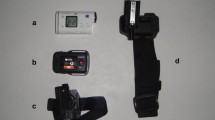Abstract
Background
The goal of telementoring is to recreate face-to-face encounters with a digital presence. Open-surgery telementoring is limited by lack of surgeon’s point-of-view cameras. Google Glass is a wearable computer that looks like a pair of glasses but is equipped with wireless connectivity, a camera, and viewing screen for video conferencing. This study aimed to assess the safety of using Google Glass by assessing the video quality of a telementoring session.
Methods
Thirty-four (n = 34) surgeons at a single institution were surveyed and blindly compared via video captured with Google Glass versus an Apple iPhone 5 during the open cholecystectomy portion of a Whipple. Surgeons were asked to evaluate the quality of the video and its adequacy for safe use in telementoring.
Results
Thirty-four of 107 invited surgical attendings (32 %) responded to the anonymous survey. A total of 50 % rated the Google Glass video as fair with the other 50 % rating it as bad to poor. A total of 52.9 % of respondents rated the Apple iPhone video as good. A significantly greater proportion of respondents felt Google Glass video quality was inadequate for telementoring versus the Apple iPhone’s (82.4 vs 26.5 %, p < 0.0001). Intraclass correlation coefficient was 0.924 (95 % CI 0.660–0.999, p < 0.001).
Conclusion
While Google Glass provides a great breadth of functionality as a wearable device with two-way communication capabilities, current hardware limitations prevent its use as a telementoring device in surgery as the video quality is inadequate for safe telementoring. As the device is still in initial phases of development, future iterations or competitor devices may provide a better telementoring application for wearable devices.






Similar content being viewed by others
References
Sebajang H, Trudeau P, Dougall A, Hegge S, McKinley C, Anvari M (2005) Telementoring: an important enabling tool for the community surgeon. Surg Innov 12:327–331
Anvari M (2007) Telesurgery: remote knowledge translation in clinical surgery. World J Surg 31:1545–1550
Rosser JC Jr, Young SM, Klonsky J (2007) Telementoring: an application whose time has come. Surg Endosc 21:1458–1463
Schulam PG, Docimo SG, Saleh W, Breitenbach C, Moore RG, Kavoussi L (1997) Telesurgical mentoring. Initial clinical experience. Surg Endosc 11:1001–1005
Rafiq A, Moore JA, Zhao X, Doarn CR, Merrell RC (2004) Digital video capture and synchronous consultation in open surgery. Ann Surg 239:567–573
Antoniou SA, Antoniou GA, Franzen J, Bollmann S, Koch OO, Pointner R, Granderath FA (2012) A comprehensive review of telementoring applications in laparoscopic general surgery. Surg Endosc 26:2111–2116
Cubano M, Poulose BK, Talamini MA, Stewart R, Antosek LE, Lentz R, Nibe R, Kutka MF, Mendoza-Sagaon M (1999) Long distance telementoring. A novel tool for laparoscopy aboard the USS Abraham Lincoln. Surg Endosc 13:673–678
Challacombe B, Wheatstone S (2010) Telementoring and telerobotics in urological surgery. Curr Urol Rep 11:22–28
Google (2014) Glass. In: Google (ed). https://www.google.com/glass
Muensterer OJ, Lacher M, Zoeller C, Bronstein M, Kubler J (2014) Google Glass in pediatric surgery: an exploratory study. Int J Surg 12(4):281–289
Engelen L (2013) Is Google Glass useful in the operating room?. LinkedIn, LinkedIncom, Mountain View
Chang J (2013) Google Glass assists surgeons and medical students at Ohio State University. ABC, ABC News, Sydney
McBeth PB, Hamilton T, Kirkpatrick AW (2010) Cost-effective remote iPhone-teathered telementored trauma telesonography. J Trauma 69:1597–1599
Crawford I, McBeth PB, Mitchelson M, Tiruta C, Ferguson J, Kirkpatrick AW (2011) Telementorable “just-in-time” lung ultrasound on an iPhone. J Emerg Trauma Shock 4:526
VQEG (2003) Final report from the video quality experts group on the validation of objective models of video quality assessment, phase II. Institute for Telecommunication Sciences, Boulder
Meireles OR, Assumpcao LR, Pawlik TM, Choti MA, Belkind N, Apelgren KN, Marohn MR (2011) Assessment and comparison of digital image quality for peritoneoscopy using the flexible endoscope and the rigid laparoscope for NOTES procedures. In: 11th World Congress of Endoscopic Surgery, Yokohama, Japan
Pinson MH, Wolf S (2004) A new standardized method for objectively measuring video quality. IEEE Trans Broadcast 50:312–322
Way LW, Stewart L, Gantert W, Liu K, Lee CM, Whang K, Hunter JG (2003) Causes and prevention of laparoscopic bile duct injuries: analysis of 252 cases from a human factors and cognitive psychology perspective. Ann Surg 237:460–469
Choy I, Fecso A, Kwong J, Jackson T, Okrainec A (2013) Remote evaluation of laparoscopic performance using the global operative assessment of laparoscopic skills. Surg Endosc 27:378–383
Jaschinski W, Heuer H, Kylian H (1998) Preferred position of visual displays relative to the eyes: a field study of visual strain and individual differences. Ergonomics 41:1034–1049
Ripple PH (1952) Variation of accommodation in vertical directions of gaze. Am J Ophthalmol 35:1630–1634
Taptagaporn S, Saito S (1993) Visual comfort in VDT operation: physiological resting states of the eye. Ind Health 31:13–28
Disclosures
Daniel A. Hashimoto, Roy Phitayakorn, Carlos Fernandez-del Castillo, and Ozanan Meireles have no conflicts of interest or financial ties to disclose.
Author information
Authors and Affiliations
Corresponding author
Rights and permissions
About this article
Cite this article
Hashimoto, D.A., Phitayakorn, R., Fernandez-del Castillo, C. et al. A blinded assessment of video quality in wearable technology for telementoring in open surgery: the Google Glass experience. Surg Endosc 30, 372–378 (2016). https://doi.org/10.1007/s00464-015-4178-x
Received:
Accepted:
Published:
Issue Date:
DOI: https://doi.org/10.1007/s00464-015-4178-x




